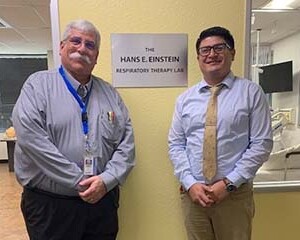Respiratory Therapy in California: Job Outlook
Whether you’re a practicing registered respiratory therapist (RRT) or thinking about becoming one, you can breathe easier knowing that California is one of the best states for RRTs. In addition to being the highest-paying state for respiratory therapists, California is also expected to need thousands of additional RRTs in coming years to meet the growing demand for professionals in the field of respiratory care.
How Much do Respiratory Therapists in California Earn?
Earning Percentiles – Respiratory Therapists in California
| Low (25th Percentile) | Median (50th Percentile) | High (75th Percentile) |
|---|---|---|
| $66957 | $80632 | $95170 |
Source: Office of Statewide Health Planning and Development
Between 2012 and 2015, the median wage for respiratory therapists in California increased by nearly $5,000 ($74,720 in 2012, $79,480 in 2015). This was significantly higher than the average wage increase for respiratory therapists nationwide over the same period of time ($57,676 in 2012, $57,790 in 2015). This isn’t surprising, considering that respiratory therapists in California are among the highest-paid in the United States. In fact, the Bureau of Labor Statistics tells us that the top 10 highest-paying metropolitan areas for this occupation are all in California:
| Metropolitan Area | Annual Mean Wage |
|---|---|
| San Francisco-Redwood City-South San Francisco | $97070 |
| Salinas | $94930 |
| San Jose-Sunnyvale-Santa Clara | $93720 |
| Santa Maria-Santa Barbara | $90690 |
| Sacramento-Roseville-Arden-Arcade | $88370 |
| Stockton-Lodi | $88320 |
| Oakland-Hayward-Berkeley | $85440 |
| Santa Rosa | $85160 |
| Vallejo-Fairfield | $84200 |
| San Luis Obispo-Paso Robles-Arroyo Grande | $83470 |
Are Respiratory Therapists in Demand in California?
Estimated Employment and Projected Growth of RTs in California
| Projected Employment (2024) | Growth (2014-2024) | Percent Growth |
|---|---|---|
| 17200 | +2500 | 17% |
Source: Office of Statewide Health Planning and Development
According to the State of California’s Employment Development Department (EDD), the number of respiratory therapists in California is expected to grow from 17,000 to 21,300 through 2026: “Much of the increased demand will come from substantial growth in the middle-aged and elderly population—a development that will heighten the incidence of cardiopulmonary disease. Job growth will also result from the expanding role of RTs in case management, disease prevention, emergency care, and the early detection of pulmonary disorders. ”
Where do Respiratory Therapists Work in California?
Respiratory Therapist Work Settings (% of RTs in Each Setting)
| Hospitals | Nursing Care | Ambulatory Care | Home Health | Other |
|---|---|---|---|---|
| 76% | 9% | 7% | 4% | 4% |
Source: California Health Care Almanac Quick Reference Guide for Respiratory Therapists
According to the most recently published data by the California Health Care Foundation, three-fourths of respiratory therapists in California work in hospitals—and the demand for RRTs in hospital settings is only expected to grow. In 2016, the California Society of Respiratory Care (CSRC) issued the Safe Staffing Standards Position Statement and White Paper to help establish respiratory staffing levels that promote the highest quality of care and safety. The CSRC collected responses from 130 respiratory care managers from hospitals throughout California. The results indicated two serious issues:
- 30% of respondents said they did not have adequate staff over the course of the past year and identified the need for additional staff in relation to patients’ needs
- Greater than 1 out of 5 hospitals (21%) indicated significant and chronic understaffing
These responses are a good indication that hospitals will look to increase the number of RRTs on staff to meet growing patient needs, which means more high-paying jobs for respiratory therapists in California.
Emerging Trend: Call for RRTs With Bachelor’s Degrees
In 2014, the Centers of Excellence, a leading source of regional workforce information and insight for community colleges in California, partnered with the Health Workforce Initiative (HWI) and the California Hospital Association (CHA) on two healthcare surveys to assess workforce needs in California.
Statewide, 190 hospitals responded to the survey. When asked about the level of formal education required for respiratory care practitioners, almost one-fourth of employers (22%) require a bachelor’s degree. Although a bachelor’s degree is not required to practice as a respiratory therapist in California, many hospitals in the state prefer or require RRTs to have an advanced degree.
Why? According to the Respiratory Care Board of California, “Increasingly, [respiratory care practitioners] are taking on responsibilities formerly held by physicians, requiring a greater level of critical thinking and analytical skills. Education at the baccalaureate level will advance the knowledge and skills in neonatal, pediatric, and adult critical respiratory care; management; clinical practice, teaching, and research.” This position echoes the call for a shift to Respiratory Therapy bachelor’s degree programs by the AARC.
Respiratory Therapy Training and Advanced Education in California
SJVC offers convenient options for those interested in becoming Respiratory Therapists in California, as well as practicing RRTs who wish to take the next step in their careers. If you are a Registered Respiratory Therapist looking to advance in your field, SJVC’s online Bachelor of Science degree completion option in Respiratory Therapy (BSRT) can provide the education needed to help you move forward.
Why Become a Respiratory Therapist
Ample job opportunities, limited education required, learn all about why to become a respiratory therapist.
You might also like
More stories about
Request Information
All fields using an asterik (*) are required.


